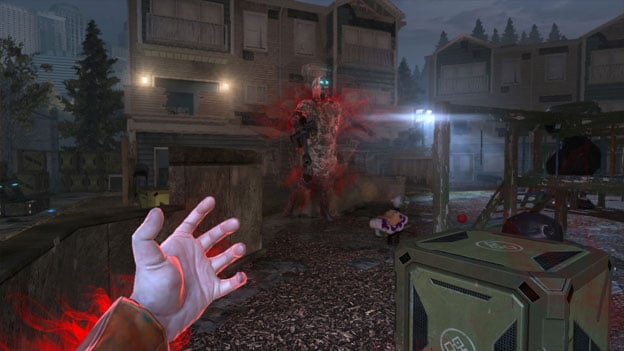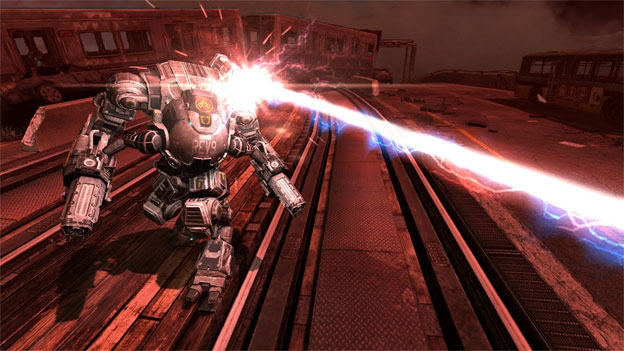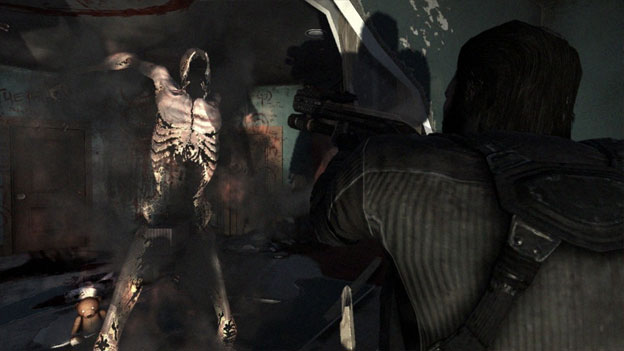Paranormal Activities
It’s been nine months since the Point Man’s failure to contain Alma, and the remaining F.E.A.R. squad members are in a desperate attempt to carry out their initial orders. Since uncovering the truth about his past, the Point Man has come to an inevitable crossroads about his allegiance. Now, separated from his squad and reunited with his brother, the Point Man’s thrilling story finally comes full-circle with F.E.A.R. 3.
Aside from the single player campaign, a huge focus has been appointed to revamping the game’s multiplayer component. In a recent hands-on session, we got to see a few of these changes with four brand-new modes featuring new styles of cooperative and competitive gameplay.

Teamwork was a common theme we noticed throughout these new game modes, and our first taste was in a mode called “Contractions.” This was probably the most unoriginal of the four new modes, but there were still plenty of good times to be had. This mode instantly drew comparisons to Call of Duty’s zombie mode, requiring players to build barricades and fight off hordes of enemies. There were a total of twenty waves in all, and these got pretty hectic once Alma’s tougher minions started rolling in.
Our first round began inside a dilapidated structure in a closed-off parking lot. The first priority was to gather a few scattered weapon crates located outside, giving us some much needed artillery. Once we returned, random weapons instantly spawned on a nearby wall, granting upgraded options to the starting pistol. These ranged from standard assault rifles and SMGs to even bigger and deadlier prototype weapons. Once the squad was fully stocked, the hordes quickly began to approach. To make things even more difficult, a dangerous fog rolled in during waves to limit visibility and give enemies the drop, including Alma herself. If players were unlucky enough to get too close, she could possess them for a short duration, rendering them helpless, or even teleport them into the center of the fog within a group of enemies.

The next mode was pretty well encapsulated by its title. “Fu**ing Run!” was hands-down the most dependant on working together as a team and made for a very entertaining experience. The map we played had us running through city streets and back alleys while trying to avoid Alma’s pursuing wall of deadly fog. The team began in a safeguarded area, where players could pick their weapons of choice and devise plans of attack. However, once we broke through the area’s threshold, we had to push through enemy soldiers that were trying to slow our advance.
Even though this mode was probably the most difficult, it was ridiculously fun. If our squad members were downed during the match, it was an absolute necessity that they were revived. Otherwise the oncoming “Wall of Death” would swallow them alive and we’d have to start again from ground zero. There were no checkpoints except for when we reached each safe haven, which made “Fu**ing Run!” feel a lot like a series of miniature Left 4 Dead campaigns with an exciting new twist.
Up next we got some quality time with a mode called “Soul King.” This mode was based more on competitive gameplay than the two previous cooperative modes. Each player started off as a wraith-like creature called a Spectre, having the ability to possess any human nearby. The goal was to collect as many human souls as possible before time ran out by killing enemy soldiers or other Spectres. Players could only do damage to others while in control of a body, but wouldn’t die entirely when killed during a possession. Instead, they’d return to their original Spectre form and become vulnerable to other players until they recaptured another body.

The gameplay in “Soul King” was fast-paced, and we needed to remain two steps ahead of our opponents to stay alive. The player with the most souls collected would appear highlighted to everyone else in the game, leaving that player as the primary target for the competitors. The most challenge aspect, and also the most entertaining, was that whenever players died they would drop all of their collected souls, forcing them to start again from scratch. This ensured that it could be anyone’s game from start to finish, and often led to some disappointed outcries from multiplayer rivals.
The last mode we were shown was a combination of both cooperative and competitive gameplay called “Soul Survivor.” This mode brought players together as a squad defending themselves from oncoming enemy soldiers, but threw a wrench in the gameplay by turning one teammate against the rest. At the start of each match, Alma would corrupt a player by turning them into a Spectre and task them with corrupting each of their former allies. The chosen player could possess human AI to lead the attack or swoop in for a last minute kill if another player had been cornered. When the Spectre was able to possess another player during the round, that player would also turn into a Spectre. This can change the tide of gameplay dramatically.
Again, this mode required a lot of teamwork, and any lone wolf-type players would likely find themselves corrupted very quickly. Luckily, the Spectre could only possess a player who has been downed, so staying together in a group was a major part of the strategy. “Soul Survivor” was not as one-sided as you might think, especially since the corrupted player was able to control any of the numerous enemies attacking the squad.
F.E.A.R. 3’s multiplayer modes were surprisingly refreshing. These looked to be a huge step away from the standard deathmatch-type modes found in every other first-person shooter, and each succeeded at finding elements relevant to the F.E.A.R. franchise. Each supported a total of four players online, featuring three maps unique to each mode (twelve in-all). Although all these modes were thoroughly entertaining, the lack in map variation could get a bit repetitive. However, that could easily be remedied through a strong amount of DLC support, which is hopefully something they plan on doing after the game releases on May 24th, 2011.
Game Features:
- F.E.A.R 3 delivers all the hallmarks that define the F.E.A.R. brand: terrifying paranormal horror, frenetic combat, and a dramatic storyline.
- Experience the evolution of the franchise with all-new Divergent Co-op: deep, social gameplay that gives players distinctly different abilities, affecting their own play as well as the experience of gamers they are playing with…or against.
- Witness the new Generative Scare System. This proprietary technology creates random scare events to increase the feeling of isolation and unpredictability when playing alone or with a friend, and offers new experiences at every turn.
- F.E.A.R 3 delivers all the hallmarks that define the F.E.A.R. brand: terrifying paranormal horror, frenetic combat, and a dramatic storyline.
F.E.A.R. and Loathing
In the F.E.A.R. series’ first two entries, Warner Bros. Interactive took some uninspiring shooter mechanics and made them interesting by combining them with a horror story. With obvious inspiration from Japanese horror flicks such as The Ring and Ju-On: The Grudge (complete with a creepy girl with long, dark hair), F.E.A.R. and F.E.A.R. 2 freaked out countless gamers with their dark atmospheres and barrages of disturbing imagery.
The big question is whether F.E.A.R. 3 — or rather, F.3.A.R., as the branding gurus who decide these things chose to title the third iteration — can push the series forward instead of treading water. Going on the information available today, we’re definitely looking forward to another round of frightening visions, and we even have hopes for a more innovative gameplay experience.

So far as the horror goes, it’s hard to believe F.3.A.R. will be any less scary than its predecessors. Not only is the series’ formula well-established and sure to chill the spine, but the developers brought on no less a horror expert than John Carpenter to help out with the cinematics. If the genius behind everything from Halloween to the underappreciated Cigarette Burns can’t give this franchise a boost, we don’t know who could. Also on board is Steve Niles, author of the 30 Days of Night comic book (which inspired the movie of the same name).
Gameplay is where the franchise is most in need of a boost; as far as killing things went, the previous two entries were cookie-cutter modern shooters. You played as a member of the military who battles paranormal threats, and the basic action felt like a poor man’s Call of Duty. Fortunately, Day 1 Studios, which is taking over development from Monolith Productions, promises some major improvements. There will be a new cover system, as well as a co-op mode. Co-op might kill the sense of isolation (as some said it did in Resident Evil 5), but it’s something new for the series, and we can’t wait to try it out. Similarly, too much emphasis on cover might take the emphasis off horror and put it on tactical fighting, but the innovation seems worth the risk.

F.3.A.R. co-op will be a little different from what you’re used to. The second player is a ghost rather than a soldier, and thus cannot use weapons unless he possesses an enemy. Most of the time, he has to use his paranormal powers (such as telekenesis) to attack the enemy and help the living player survive. In addition to setting this iteration apart from its predecessors, this feature will add to replay value, because most players will want to beat the game with both players. Unfortunately, however, only the human is controllable in single-player games. We just hope the ghost’s A.I. will be good enough that single-player gamers won’t be left out of the F.3.A.R. experience completely.
The cover system, meanwhile, has been provoking comparisons to Gears of War. Most likely, this means a lot of pop-and-shoot sequences. Also, combined with the addition of a second player, it will allow you to flank enemies and revive your teammate when he gets killed. What’s more, a new enemy-spawning system allows bad guys to come from anywhere, so you can no longer just memorize the patterns. This is a problem with the entire first-person shooter genre, so if it works, other developers might take note. Hopefully, all of this will work together to make combat a more memorable experience than it has been in the F.E.A.R. franchise to date. Shooting shouldn’t just be something you do between looking at blood smears and angry ghosts.

The plot will pick up where F.E.A.R. 2 (or, as we’ve taken to calling it, F.E.A.2.) left off. Alma, the creepy long-haired girl who haunts the series thanks to (what else?) a military experiment gone haywire, is pregnant with the child of Sgt. Michael Becket, the protagonist of F.E.A.R. 2. You play either as Point Man (the soldier) or as Paxton Fettel (the ghost). Point Man and Paxton are Alma’s sons, and they were the main character and antagonist respectively of the original game. The idea, of course, is to end the reign of destruction that Alma’s spirit has visited on the world. Two brothers with a history of not getting along, one of whom is dead, and an evil ghost mother? Sounds like an opportunity to mix some family drama in with the horror.
Up until now, the F.E.A.R. games have given us great moments of terror interspersed with mediocre action. The developers seem aware of this, and are seeking to keep the horror going with improved combat mechanics. Given they’ve assembled a great team, borrowed the cover system from Gears of War, and implemented an interesting new co-op mode, we’re eagerly awaiting the results.
Game Features:
- F.E.A.R 3 delivers all the hallmarks that define the F.E.A.R. brand: terrifying paranormal horror, frenetic combat, and a dramatic storyline.
- Experience the evolution of the franchise with all-new Divergent Co-op: deep, social gameplay that gives players distinctly different abilities, affecting their own play as well as the experience of gamers they are playing with…or against.
- Witness the new Generative Scare System. This proprietary technology creates random scare events to increase the feeling of isolation and unpredictability when playing alone or with a friend, and offers new experiences at every turn.
- F.E.A.R 3 delivers all the hallmarks that define the F.E.A.R. brand: terrifying paranormal horror, frenetic combat, and a dramatic storyline.
